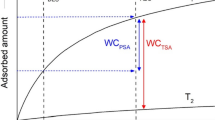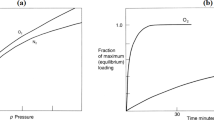Abstract
Commercial gas separation plants running adsorption processes, including pressure swing adsorption, vacuum pressure swing adsorption and temperature swing adsorption are intended to operate continuously and meet design performance levels over the complete service life of the facility. Performance degradation of the adsorbent materials in extended commercial usage is a common problem. Issues such as adsorbent aging and poisoning by unwanted or unexpected contaminants, represent some of the causes of declining adsorbent performance. Lower adsorption capacity can result in declining productivity and/or product purity for the gas separation plant. Adsorbent troubleshooting is usually accomplished by taking samples from the plant and sending them to off-site laboratories for analyses such as moisture content determination by Karl Fischer titration, or BET surface area or other adsorption capacity measurements. The turnaround time for these laboratory analyses is on the order of days. To short-cut this lengthy process of analysis, we have developed a simple test method and kit for rapid diagnosis of adsorbent performance issues which can be used directly at a plant site. The test method involves the determination of the gas capacity of an adsorbent by equilibrating the adsorbent with an appropriate test gas, deactivating the adsorbent and measuring the amount of test gas released. Once a sample has been acquired, the test can be executed and results obtained in less than 15 min. We show that the test method is accurate to within 5 % of the adsorption capacity determined from isotherm measurements, at equivalent temperature and pressure, and can be used to test common commercial adsorbent types, including low silica zeolites and activated carbons.






Similar content being viewed by others
References
Ackley, M.W., Leavitt, F.W.: Rate enhanced gas separation. US Patent 6,500, 234 2002
Brunauer, S., Emmett, P.H., Teller, E.: Adsorption of gases in multimolecular layers. J. Am. Soc. 60, 309–319 (1938)
Hutson, N.D., Zajic, S.C., Yang, R.T.: Influence of residual water on the adsorption of atmospheric gases in Li–X zeolite: experiment and simulation. Ind. Eng. Chem. Res. 39, 1775–1780 (2000)
MacLeod, S.K.: Moisture determination using Karl Fischer titrations. Anal. Chem. 63, 557–566 (1991)
Pfenninger, A.: Manufacture and Use of Zeolites for Adsorption Processes, Molecular Sieves Science and Technology, 2nd edn, pp. 165–197. Springer-Verlag, Berlin (1999)
Sircar, S., Myers, A.L.: Gas Separation by Zeolites, Handbook of Zeolite Science and Technology. Marcel Dekker Inc., New York (2003). ISBN 0-8247-40203
Stephenson, N.A., Barrett, P.A., Pontonio, S.J., Freiert, M.T., Gallego-Preciado, J.: Method and kit for adsorbent performance evaluation. US Patent 7,827,855, 2008
Webb, P.A., Orr, C.: Analytical Methods in Fine Particle Technology. Micromeritics Instrument Corporation, Norcross (1997). ISBN 0-9656783-0-X
Author information
Authors and Affiliations
Corresponding author
Rights and permissions
About this article
Cite this article
Stephenson, N.A., Pontonio, S.J., Freiert, M.T. et al. Method and kit for adsorbent performance evaluation. Adsorption 20, 417–426 (2014). https://doi.org/10.1007/s10450-013-9590-8
Received:
Accepted:
Published:
Issue Date:
DOI: https://doi.org/10.1007/s10450-013-9590-8




